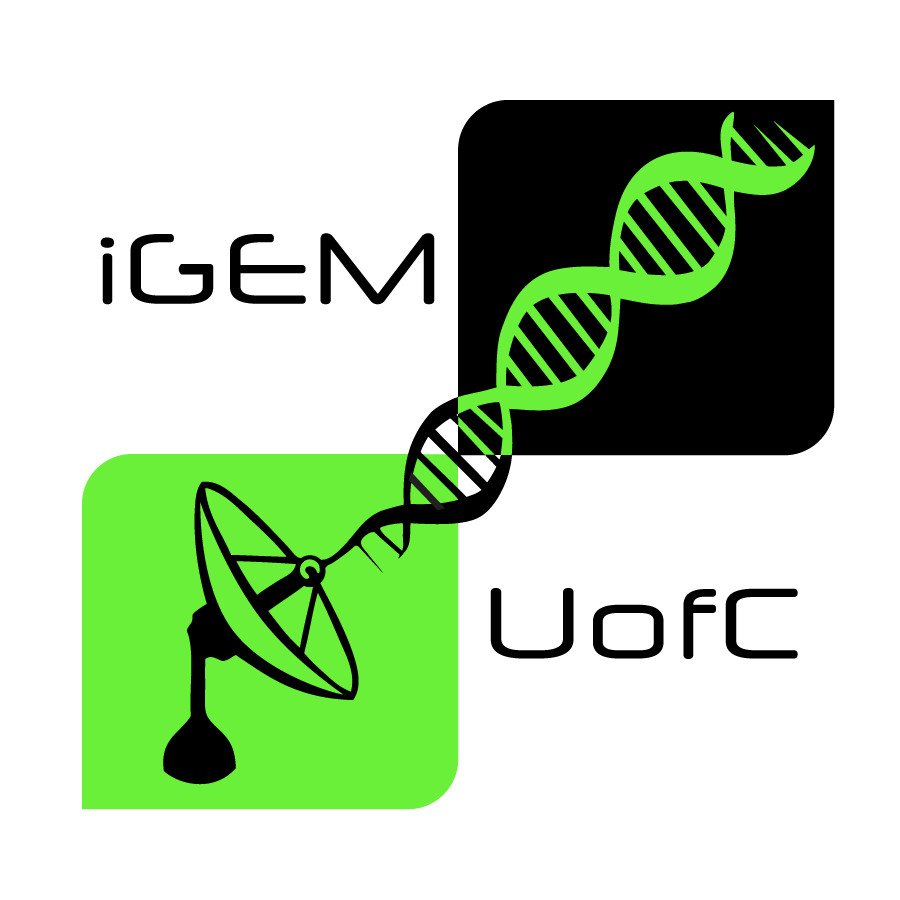Team:Calgary
From 2009.igem.org
(Difference between revisions)
| Line 498: | Line 498: | ||
<br> | <br> | ||
(1)Waters, C.M. & Bassler, B.L.. Quorum sensing: cell-to-cell communication in bacteria. Annu. Rev. Cell Dev. Biol. 21, 319-346 (2005). | (1)Waters, C.M. & Bassler, B.L.. Quorum sensing: cell-to-cell communication in bacteria. Annu. Rev. Cell Dev. Biol. 21, 319-346 (2005). | ||
| + | <br> | ||
(2)Hardman, A.M., Stewart, G.S. & Williams P. Quorum sensing and the cell-cell communication dependent regulation of gene expression in pathogenic and non-pathogenic bacteria. Antonie van Leeuwenhoek. 74, 199-210 (1998). | (2)Hardman, A.M., Stewart, G.S. & Williams P. Quorum sensing and the cell-cell communication dependent regulation of gene expression in pathogenic and non-pathogenic bacteria. Antonie van Leeuwenhoek. 74, 199-210 (1998). | ||
| + | <br> | ||
(3)Nealson, K. H., Platt, T. & Hastings, W. Cellular Control of the synthesis and activity of the bacterial bioluminescent system. J. Bacteriol. 104, 313-322 (1970). | (3)Nealson, K. H., Platt, T. & Hastings, W. Cellular Control of the synthesis and activity of the bacterial bioluminescent system. J. Bacteriol. 104, 313-322 (1970). | ||
| + | <br> | ||
(4)Eberhard, A., Burlingame, A.L., Kenyon, G.L., Nealson, K.H. & Oppenheimer, N.J. Structural identification of autoinducer of Photobacterium fischeri luciferase. Biochemistry. 20, 2444-2449 (1981). | (4)Eberhard, A., Burlingame, A.L., Kenyon, G.L., Nealson, K.H. & Oppenheimer, N.J. Structural identification of autoinducer of Photobacterium fischeri luciferase. Biochemistry. 20, 2444-2449 (1981). | ||
| + | <br> | ||
(5)Sun, J., Daniel, R., Wagner-Dobler I. & Zeng, A.P. Is autoinducer-2 a universal signal for interspecies communication: a comparative genomic and phylogenetic analysis of the synthesis and signal transduction pathways, BMC Evol. Biol. 4, 36 (2004). | (5)Sun, J., Daniel, R., Wagner-Dobler I. & Zeng, A.P. Is autoinducer-2 a universal signal for interspecies communication: a comparative genomic and phylogenetic analysis of the synthesis and signal transduction pathways, BMC Evol. Biol. 4, 36 (2004). | ||
| + | <br> | ||
(6)Bassler, B.L., Wright, M., Silverman, M.R. Multiple signaling systems controlling expression of luminescence in Vibrio harveyi: sequence and function of genes encoding a second sensory pathway. Mol. Microbiol. 13, 273-286 (1994). | (6)Bassler, B.L., Wright, M., Silverman, M.R. Multiple signaling systems controlling expression of luminescence in Vibrio harveyi: sequence and function of genes encoding a second sensory pathway. Mol. Microbiol. 13, 273-286 (1994). | ||
| + | <br> | ||
(7)Lilley, B.N. & Bassler, B.L. Regulation of quorum sensing in Vibrio harveyi by LuxO and sigma-54. Mol. Microbiol. 36, 940–54 (2000). | (7)Lilley, B.N. & Bassler, B.L. Regulation of quorum sensing in Vibrio harveyi by LuxO and sigma-54. Mol. Microbiol. 36, 940–54 (2000). | ||
| + | <br> | ||
(8)Lenz, D.H., Mok, K.C., Lilley, B.N., Kulkarni, R.V., Wingreen, N.S. & Bassler, B.L.The small RNA chaperone Hfq and multiple small RNAs control quorum sensing in Vibrio harveyi and Vibrio cholerae. Cell 118, 69–82 (2004) | (8)Lenz, D.H., Mok, K.C., Lilley, B.N., Kulkarni, R.V., Wingreen, N.S. & Bassler, B.L.The small RNA chaperone Hfq and multiple small RNAs control quorum sensing in Vibrio harveyi and Vibrio cholerae. Cell 118, 69–82 (2004) | ||
| + | <br> | ||
(9)Swartzman, E., Silverman, M. & Meighen, E.A. The luxR gene product of Vibrio harveyi is a transcriptional activator of the lux promoter. J. Bacteriol. 174, 7490–7493 (1992) | (9)Swartzman, E., Silverman, M. & Meighen, E.A. The luxR gene product of Vibrio harveyi is a transcriptional activator of the lux promoter. J. Bacteriol. 174, 7490–7493 (1992) | ||
Revision as of 17:08, 16 September 2009
UNIVERSITY OF CALGARY

|
iGEM - INTERNATIONAL GENETICALLY ENGINEERED MACHINES
The iGEM competition is a synthetic biology competition held annually at Massachusetts Institute of Technology (MIT) in November. Started in 2004, the iGEM Jamboree brings together teams from multiple universities to compete on an international stage. The competition allows undergraduate teams from all over the world to be part of the emerging field of Synthetic Biology, an intertwining of principles from Biology and Engineering. For more information about iGEM, please visit their official website.
The U of C iGEM team is made up of 15 undergraduate students from Health Sciences, Engineering, Computer Science and Kinesiology as well as 4 facilitators. For more information regarding the U of C iGEM Enterprise, please visit our website. |
|
|
NAVIGATION
Need help navigating our site? Click HERE for a navigational guide and sitemap. Or, follow our tour:
A TOUR OF iGEM CALGARY

Welcome to the iGEM Calgary wiki! This tour will give you a broad overview of our project, through our different subgroups and what we've been up to lately. This is the first step of our tour! Here you can click and see a few pictures of our adventures in synthetic biology, as well as leave some comments and read a brief overview of iGEM (which is above) and of our project (which is below). Once you've finished exploring our front page, please click HERE for an intro to our team! |
|
|
THE PROJECT - COMMUNICATION
QUORUM SENSING and OUR PROJECT
Bacteria are able to communicate by producing and releasing chemical signal molecules termed autoinducers in a process called Quorum Sensing (QS) (1). An increase in local population density of bacteria results in the accumulation of autoinducers until a minimal threshold concentration is reached, whereby bacteria are able to organize their behaviour by coordinating their gene expression. Such coordinated behaviour includes virulence induction, swarming, biofilm formation and genetic competence (2).
QS was first observed in the bioluminescent bacteria Vibrio fischeri (3), where light was emitted only at high population densities, but could be induced in low population densities with the presence of an extracellular substance, later identified as the autoinducer N-acylhomoserine (AHL) (4). Further research in QS led to the discovery of the universal signaling molecule (5) autoinducer-2 (AI-2), which has been characterized in the gram-negative, bioluminescent marine bacterium Vibrio harveyi (1). AI-2 binds to the periplasmic protein LuxP forming an AI-2-LuxP complex that interacts with LuxQ, a membrane bound histidine kinase (6). At low population density corresponding to low AI-2 levels, this AI-2 signalling acts as a phosphorylation cascade, resulting in the phosphorylated form of luxO. Phospho-LuxO complexes with transcription factor σ54 to activate the transcription of the genes encoding five regulatory small RNAs (sRNAs) termed Qrr1-5 (7). These sRNAs bind and destabilize the mRNA of luxR (8) , a transcriptional activator of the luciferase operon luxCDABE (9). As the mRNA of luxR is degraded in the presence of low levels of AI-2 and low cell density, V. harveyi will not express bioluminescence. In high population densities and thus high AI-2 levels, LuxQ changes from a kinase to a phosphotase, and the result is unphosphorylated LuxO (1). There is no complexing with σ54, and no production of sRNAs. This leads to unblocked luxR mRNA allowing its translation that drives the expression of bioluminescence via luciferase. We, the University of Calgary's 2009 iGEM team, have engineered this Vibrio harveyi AI-2 signaling system in Escherichia coli using the molecular cloning techniques used in the International Genetically Engineered Machines (iGEM) competition. This system is coupled with the expression of aiiA, a gene that encodes an AHL-degrading enzyme partaking in quorum quenching, allowing us to target biofilm maintenance. References (1)Waters, C.M. & Bassler, B.L.. Quorum sensing: cell-to-cell communication in bacteria. Annu. Rev. Cell Dev. Biol. 21, 319-346 (2005). (2)Hardman, A.M., Stewart, G.S. & Williams P. Quorum sensing and the cell-cell communication dependent regulation of gene expression in pathogenic and non-pathogenic bacteria. Antonie van Leeuwenhoek. 74, 199-210 (1998). (3)Nealson, K. H., Platt, T. & Hastings, W. Cellular Control of the synthesis and activity of the bacterial bioluminescent system. J. Bacteriol. 104, 313-322 (1970). (4)Eberhard, A., Burlingame, A.L., Kenyon, G.L., Nealson, K.H. & Oppenheimer, N.J. Structural identification of autoinducer of Photobacterium fischeri luciferase. Biochemistry. 20, 2444-2449 (1981). (5)Sun, J., Daniel, R., Wagner-Dobler I. & Zeng, A.P. Is autoinducer-2 a universal signal for interspecies communication: a comparative genomic and phylogenetic analysis of the synthesis and signal transduction pathways, BMC Evol. Biol. 4, 36 (2004). (6)Bassler, B.L., Wright, M., Silverman, M.R. Multiple signaling systems controlling expression of luminescence in Vibrio harveyi: sequence and function of genes encoding a second sensory pathway. Mol. Microbiol. 13, 273-286 (1994). (7)Lilley, B.N. & Bassler, B.L. Regulation of quorum sensing in Vibrio harveyi by LuxO and sigma-54. Mol. Microbiol. 36, 940–54 (2000). (8)Lenz, D.H., Mok, K.C., Lilley, B.N., Kulkarni, R.V., Wingreen, N.S. & Bassler, B.L.The small RNA chaperone Hfq and multiple small RNAs control quorum sensing in Vibrio harveyi and Vibrio cholerae. Cell 118, 69–82 (2004) (9)Swartzman, E., Silverman, M. & Meighen, E.A. The luxR gene product of Vibrio harveyi is a transcriptional activator of the lux promoter. J. Bacteriol. 174, 7490–7493 (1992) |
|
|
LATEST NEWS
Tour of the Oil Sands @ Fort McMurray, August 10th-11th
On August 10th and 11th nine members of the U of C team and 2 facilitators, along with some team members and facilitators from U of L and U of A had the opportunity to go on a tour of the Oil Sands near Fort McMurray.
The trip included tours of both Suncor and ConocoPhilips sites as well as a trip to the Oil Sands Discovery Centre. The trip was interesting as it got us thinking about how synthetic biology could possibly have an impact on the sustainability of oils ands projects: offering solutions to some of the problems facing oil sands projects today. For more details, click HERE.
|
|
|
STATS & COMMENTS
|
 "
"




































